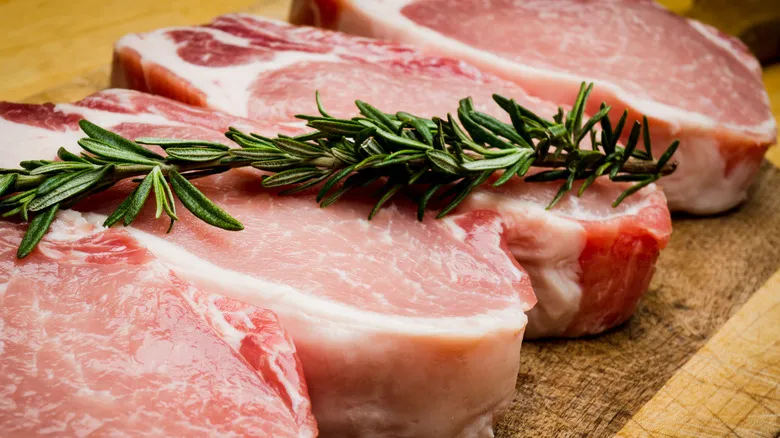What is the easier cut to grill – bone-in or boneless?
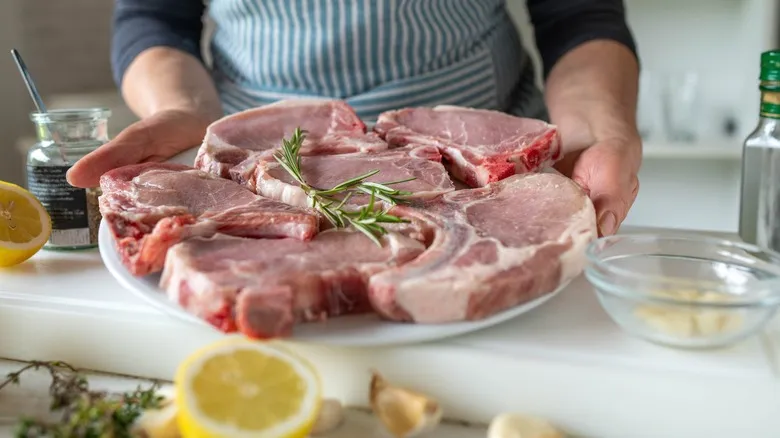
You've chosen pork chops for dinner, but first, you need to decide: bone-in or boneless? Bone-in pork chops are generally easier to grill, as they offer less room for mistakes and yield delicious results. "Whenever possible, go for bone-in pork chops! The bone shields the meat from direct heat, resulting in a juicier final dish," advises Max. With just a bit of seasoning and medium to high heat on the grill, you're all set with bone-in chops.
Both options are typically lean, flavorful, and incredibly versatile, making them great choices for a variety of meals. However, there are notable differences in texture and taste. Bone-in chops are often favored for their slightly higher fat content and reasonable price. In contrast, boneless chops cook quickly and are very lean, making them a convenient, no-fuss dinner option any day of the week. Ultimately, boneless chops are worth considering if you're looking for a quick meal and don't mind a bit of extra preparation. Just be sure to keep an eye on them, as boneless pork chops can dry out if grilled too long.
What is the secret to grilling up delicious pork chops?
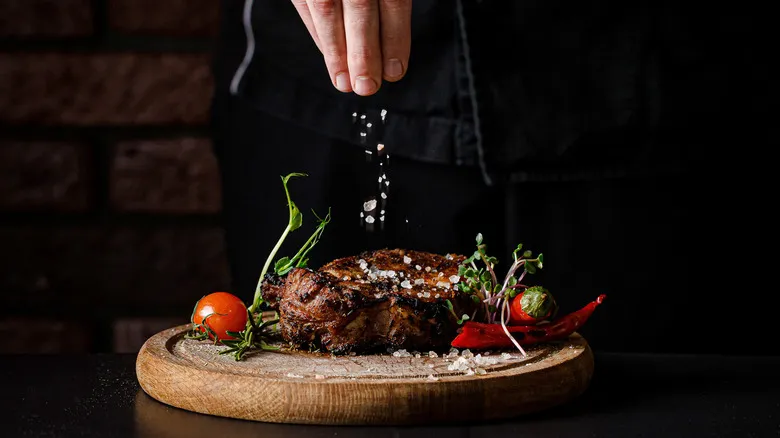
Grilling up mouthwatering pork chops doesn't have to be a rare treat. While marinating your chops in flavorful mixtures will certainly enhance their taste, the key to achieving exceptional grilled chops actually starts at the grocery store. It's essential to choose high-quality cuts for a memorable meal. "Opt for a bone-in pork chop with plenty of marbling for improved tenderness, juiciness, and flavor," advises Max.
Marbling, which refers to the fat interspersed with lean muscle, is crucial for creating a delectable chop. To find quality chops with good marbling, your best option is to visit a local butcher shop, as they typically offer superior meats. Once you've selected the finest pork chops, don't forget to season the meat. A simple sprinkle of salt and pepper can significantly elevate the flavor of your chops. Additionally, a generous application of spices and herbs before grilling can be transformative and can complement your homemade marinade beautifully.
Should you tenderize pork chops before putting them on the grill?
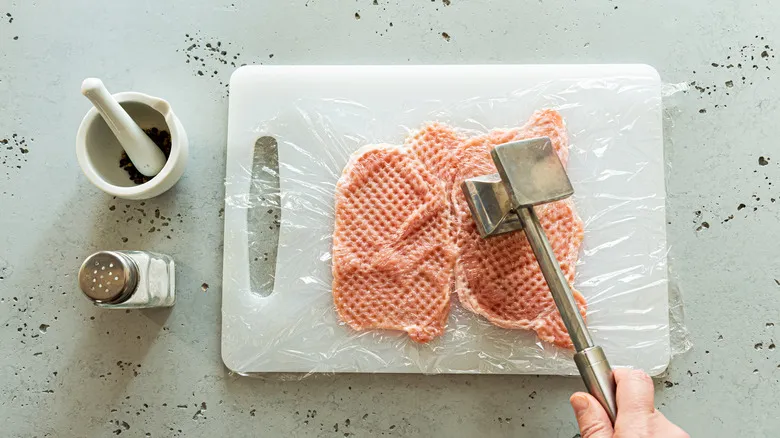
Since pork chops are a lean source of protein, tenderizing them before grilling can significantly enhance their texture. However, if you've chosen high-quality chops, you might be able to skip this step, as experts suggest. "Tenderizing pork chops isn't necessary — if the chop is a loin cut, similar to a ribeye steak, it is naturally tender," explains Max.
That said, there are five main types of pork chops: rib, boneless, porterhouse, shoulder, and sirloin. Tenderizing non-loin cuts may be necessary, as they tend to be less tender and may lack adequate marbling. If you do need to tenderize your lean pork, there are several effective methods. Common techniques include using a meat mallet, marinating, brining, and braising (though braising is generally not recommended for grilling). Most of these methods are effective for boneless pork chops, but they aren't essential, especially for bone-in varieties. When grilling your pork chops, be sure to position them on the medium rack to avoid overcooking.
When should you season pork chops before, during, or after they are grilled?
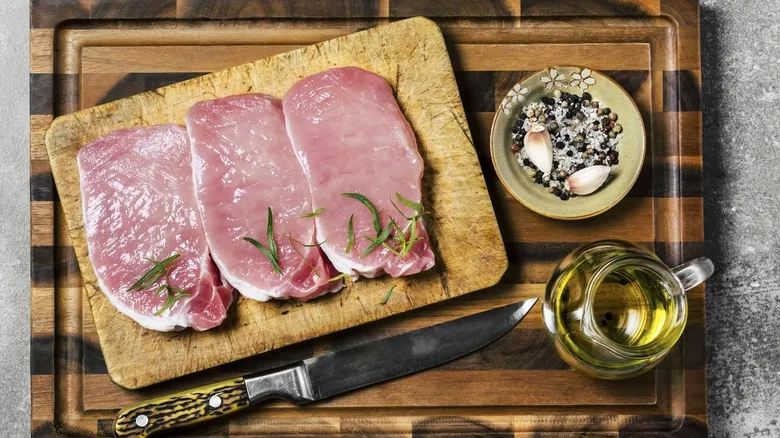
Seasoning pork chops should be done before grilling. Applying your preferred spices and herbs prior to cooking will not only help keep the meat tender and juicy but also enhance the overall flavor of the cut. Since this specific cut of pork can be somewhat bland on its own, experts recommend seasoning it beforehand. "Always season pork chops before cooking," advises Max. "If you have the time, consider using a method called dry brining."
Dry brining primarily uses salt to enhance your chops without adding water. This technique, favored by grill masters and professional chefs alike, does require some additional preparation time. "To do this, season your pork chop at least one hour before cooking, ideally the day before. Once well-coated, place the pork chops on a rack and loosely cover them before refrigerating," Max recommends. After the dry brining process, it’s important to remove any excess salt before cooking, so be sure to give your chops a quick wipe and blot them dry before grilling.
How long should you grill pork chops for?

If you're short on time and ready to fire up the grill, there's no need to worry. A sprinkle of your favorite spice blend is all you need to kick off dinner. When it's time to place those well-seasoned chops on your preheated grill, you can expect to sear each chop for about 2 to 3 minutes per side, on average. Keep in mind that cooking times may vary based on the size, thickness, and type of chop (shoulder, rib, boneless, sirloin, or loin).
In addition to the searing time, smaller, boneless chops may require a few extra minutes on the grill, with a total cooking time of around 7 minutes. On the other hand, thicker, bone-in, and larger pork chops typically take up to 20 minutes to cook thoroughly, including the time needed for proper searing.
What temperature is best for grilling pork chops?

As Max points out, preheating the grill is essential before you start cooking. Before you start the countdown for your pork chop dinner, make sure to preheat your grill to around 375-400°F as soon as possible. "Dry brining is crucial for achieving the ideal sear," Max explains. "By reducing surface moisture, the pork chop can form a delicious crust during cooking, which helps avoid any 'steaming' effect." Instead, you'll experience the Maillard reaction, a chemical process that transforms surface proteins into the caramelized, crispy edges we all love. To achieve a perfect sear on your chops, find the hottest part of the grill grate and place your chops over direct medium to high heat, allowing a nice crust to form.
After searing your chops on both sides, move them away from the direct heat and continue cooking with indirect heat until the internal temperature reaches between 145°F and 160°F. Regardless of whether you're using a gas, electric, or charcoal grill, pork is safe to eat when it hits 145°F, which is considered medium-rare. For those who prefer a more well-done cut, aim for an internal temperature of 160°F. The best way to ensure your chops are cooked to perfection is by using a meat thermometer—so consider investing in one if you haven't done so already.
Can you get the same intense flavors you get when you smoke pork chops versus grilling them?

For many barbecue enthusiasts, grilling and smoking meats are closely intertwined. However, these cooking techniques produce slightly different outcomes. This distinction is logical, as grilling involves a direct heat source, while smoking utilizes indirect heat. Moreover, when you choose to grill pork chops, no one anticipates you spending hours outside—it's all about cooking quickly and at high temperatures. In contrast, a smoker allows for slow cooking at lower temperatures, enhancing the flavor profile of your meat. So, what does this imply for your delicious grilled pork chops? Is it impossible to achieve the same rich flavors that smoking imparts?
"There’s no true replacement for authentic hardwood smoke flavor, but being choosy with your seasonings can make a difference," explains Max. "When grilled, these coarse seasonings will caramelize, adding aromatic and smoky notes." Furthermore, grilling your pork chops over a wood fire can impart flavors similar to those from a smoker, particularly if you use hickory wood, which is renowned for enhancing various pork cuts. Regardless, replicating the bold taste and unmistakably enticing barbecue aroma that comes from smoking chops is a challenge—you just need the right spices and the expertise to transform almost any grill into a smoker.
How can you avoid drying out your chops on the grill?
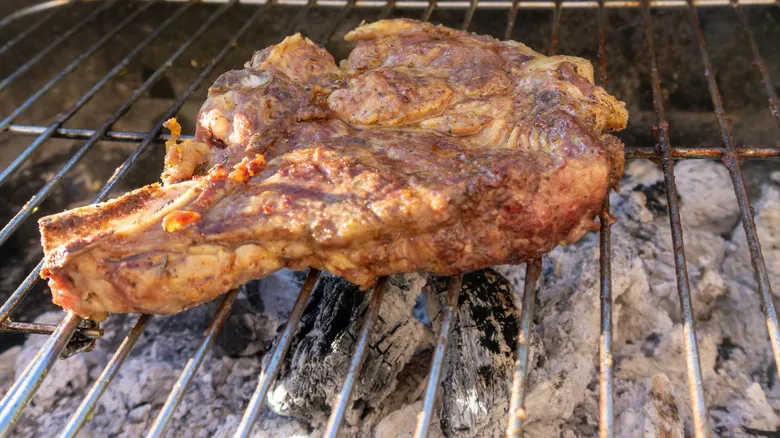
No one enjoys a dry pork chop, so how can you keep this lean cut of meat from becoming overcooked? Paying attention to cooking temperatures and closely monitoring your chops while grilling outdoors will help prevent them from drying out or burning. Beyond these fundamental grilling tips, it really comes down to two key steps: using a reliable brining technique and seasoning your pork chops properly.
This is the key to achieving tender and juicy chops. For a classic brine, simply mix 1 tablespoon of kosher salt and 2 tablespoons of granulated or brown sugar for every cup of water. You can also enhance the flavor by adding herbs or spices, such as garlic. Alternatively, you might consider a dry brine or a simple marinade.
After letting your pork chops marinate or brine for several hours, it’s advisable to pat the meat dry and apply a straightforward homemade rub. However, if you prefer to skip the rub or additional seasoning after brining, just dry off your chops and drizzle a bit of olive oil, along with a pinch of salt (if desired) and a sprinkle of freshly ground black pepper. Following this two-step approach will help ensure your pork chops remain moist and flavorful.
Do you need to let pork chops rest after grilling?
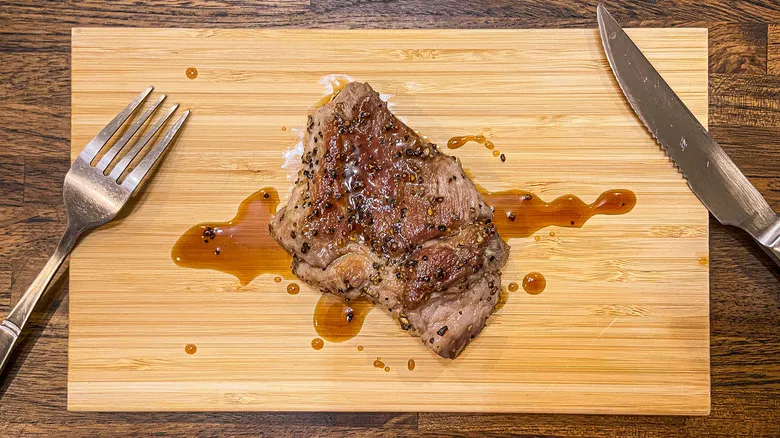
As with most proteins, allowing your pork chops to rest after cooking is an essential tip that shouldn't be ignored. "Let your grilled pork chops rest for about 5 to 10 minutes before slicing. Essentially, treat your pork chop just like you would a premium steak," advises Max. This process, known as carryover cooking, enables your meat to continue cooking even after being removed from the heat source.
For thinner or boneless cuts, a resting period of just 5 minutes is sufficient before serving. On the other hand, thicker (1 to 1½ inches), larger, or bone-in chops should rest for around 8 to 10 minutes. If you enjoy your pork chops medium rare, it's perfectly fine to take them off the grill when they reach an internal temperature of 140°F or slightly lower. This approach allows you to enjoy juicy and tender pork chops while ensuring they finish cooking without becoming overdone. A helpful tip: before slicing, plating, and serving, check the internal temperature of your chops to confirm that the thickest part has reached 145°F, ensuring they are safe to eat.
What sides work best with grilled pork chops?
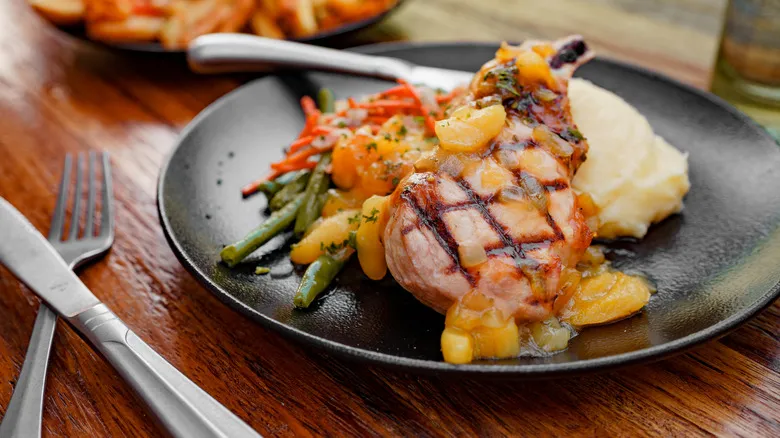
Once you've perfected the technique of grilling pork chops, you can shift your attention to the side dishes. Whether you prefer something straightforward like mashed potatoes, sautéed vegetables, or a mix of both, there are numerous accompaniments that pair wonderfully with grilled chops. "Serving your pork chops alongside roasted pumpkin, sweet potato fries, or a fresh apple cider vinegar coleslaw is always a crowd-pleaser," notes Max.
But that's just the beginning — options abound, from mac and cheese and collard greens to cornbread muffins and mango salsa, when it comes to side dishes that complement grilled chops. Given the versatility of pork chops, you really can't go wrong. However, depending on the seasonings you choose, some sides may complement the flavors better than others, so it's wise to consider that. Additionally, if you're pressed for time, it's perfectly fine to opt for sides that pair well with nearly any meal, such as broccoli, green beans, and everyday starches like rice, pasta, potatoes, and bread. The options are truly limitless when it comes to sides for this delicious cut of meat.
Are there any specific grilling tips one should know to make the perfect pork chop every time?
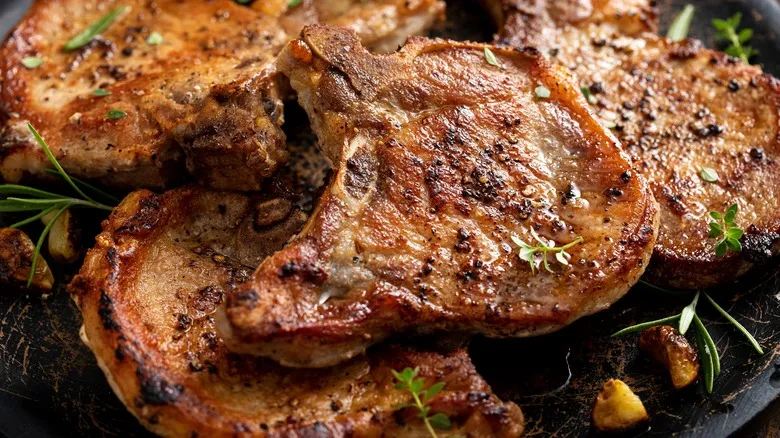
With a vivid image of your pork chop dinner in mind, you're almost there, but what’s the key takeaway? A crucial grilling tip that often gets overlooked is the significance of thickness. Choosing a thicker chop is essential to prevent overcooking. While you're at it, be sure to generously season all sides of your thick chops for maximum flavor.
Another useful technique is to set up your grill for dual-zone cooking—creating a hot side and a cooler side. This allows you to quickly sear your chops and then transfer them to the cooler side to finish cooking. When it comes to searing, Max has a few pointers. "For thicker pork chops, consider reverse searing. Start by cooking them on the cooler side of the grill," he advises. "Cook until the internal temperature reaches about 100°F, then sear on the hot side, flipping frequently, until fully cooked." This gradual cooking method will yield the juiciest chops that practically fall off the bone. Ultimately, once you have the right chops, it’s all about following the steps—brine, season, sear, grill, and let them rest before serving with some amazing sides.
Recommended

The One Thing Ina Garten's Husband Jeffrey Makes In The Kitchen

Where In The World You'll Find Reindeer Cheese In Your Coffee

How Many Shots Of Espresso Are In One Pound Of Coffee?

What's The Most Caffeinated Coffee Drink On Dunkin's Menu?
Next up

